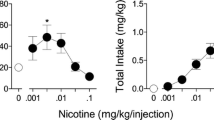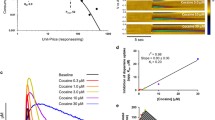Abstract
Rationale
To provide a prospective test of the predictive adequacy of the exponential model of demand (Hursh and Silberberg, Psych Rev 115(1):186–198, 2008).
Objectives
In Experiment 1, to measure the ‘essential value’ (the propensity to defend consumption with changes in price) of cocaine and food in a demand analysis (functional relation between price and consumption) by means of the exponential model; in Experiment 2, to test whether the model’s systematic underestimation of cocaine consumption in Experiment 1 was due to weight loss; and in Experiment 3, to evaluate the effects of cocaine on the essential value of food.
Materials and methods
In Experiment 1, demand curves for food and cocaine were determined by measuring consumption of these goods in a multiple schedule over a range of fixed ratios; in Experiment 2, a demand curve for only cocaine was determined; and in Experiment 3, demand for food was determined in the absence of cocaine.
Results
In Experiment 1, the exponential equation accommodated high portions of variance for both curves, but systematically underestimated cocaine demand; in Experiment 2, this predictive underestimation of the equation was eliminated; and in Experiment 3, the essential value of food was greater than in Experiment 1.
Conclusions
The exponential model of demand accommodated the data variance for all cocaine and food demand curves. Compared to food, cocaine is a good of lower essential value.






Similar content being viewed by others
References
Ahmed SH, Cador M (2005) Dissociation of psychomotor sensitization from compulsive cocaine consumption. Neuropsychopharmacology 31(3):563–571
Ahmed SH, Koob GF (1998) Transition from moderate to excessive drug intake: change in hedonic set point. Science 282:298–301
Ahmed SH, Koob GF (1999) Long-lasting increase in the set point for cocaine self-administration after escalation in rats. Psychopharmacology 146:303–312
Aigner TG, Balster RL (1978) Choice behavior in rhesus monkeys: cocaine versus food. Science 201:534–535
Balopole DC, Hansult CD, Dorph D (1979) Effect of cocaine on food intake in rats. Psychopharmacology 64:121–122
Bergman J, Katz JL (1998) Behavioral pharmacology of cocaine and the determinants of abuse liability. In: Higgins ST, Katz JL (eds) Cocaine abuse: behavior, pharmacology, and clinical applications. Academic , New York, pp 51–79
Childs E, Shoaib M, Stolerman IP (2006) Cocaine self-administration in rats with histories of cocaine exposure and discrimination. Psychopharmacology 286:168–176
Deneau G, Yanagita T, Seevers MH (1969) Self-administration of psychoactive substances by the monkey. Psychopharmacologia 16:30–48
Deroche-Gamonet V, Belin D, Piazza PV (2004) Evidence for addiction-like behavior in the rat. Science 305:1014–1017
Elsmore TF, Fletcher GV, Conrad DG, Sodetz FJ (1980) Reduction of heroin intake in baboons by an economic constraint. Pharmacol Biochem Behav 13:729–731
Foltin RW, Fischman MW (1994) Effects of buprenorphine on the self-administration of cocaine by humans. Behav Pharmacol 5:79–89
Gardner EL (2000) What we have learned about addiction from animal models of drug self-administration. Am J Addict 9:285–313
Herrnstein RJ (1970) On the law of effect. J Exp Anal Behav 13:243–266
Hodos W (1961) Progressive ratio as a measure of reward strength. Science 134:943–944
Hursh SR (1984) Behavioral economics. J Exp Anal Behav 42:435–452
Hursh SR, Silberberg A (2008) Economic demand and essential value. Psychol Rev 115(1):186–198
Hursh SR, Raslear TG, Bauman R, Black H (1989) The quantitative analysis of economic behavior with laboratory animals. In: Grunert KG, Olander F (eds) Understanding economic behavior. Kluwer Academic, Dordrecht, Netherlands, pp 383–407
Kippin TE, Fuchs RA, See RE (2006) Contributions of prolonged contingent and noncontingent cocaine exposure to enhanced reinstatement of cocaine seeking in rats. Psychopharmacology 187:60–67
Kitamura O, Wee S, Specio SE, Koob GF, Pulvirenti L (2006) Escalation of methamphetamine self-administration in rats: a dose-effect function. Psychopharmacology 186:48–53
Liu Y, Roberts DCS, Morgan D (2005) Effects of extended-access self-administration and deprivation on breakpoints maintained by cocaine in rats. Psychopharmacology 179:644–651
Macenski MJ, Meisch RA (1999) Cocaine self-administration under conditions of restricted and unrestricted food access. Exp Clin Psychopharmacol 7:324–337
Mantsch JR, Yuferov V, Mathieu-Kia AM, Ho A, Kreek MJ (2004) Effects of extended access to high versus low cocaine doses on self-administration, cocaine-induced reinstatement and brain mRNA levels in rats. Psychopharmacology 175:26–36
Nevin JA (1992) An integrative model for the study of behavioral momentum. J Exp Anal Behav 57:301–316
Panlilio LV, Weiss SJ, Schindler CW (1996) Cocaine self-administration increased by compounding discriminative stimuli. Psychopharmacology 125:202–208
Paterson NE, Markou A (2003) Increased motivation for self-administered cocaine after escalated cocaine intake. NeuroReport 14:2229–2232
Pelloux Y, Everitt BJ, Dickinson A (2007) Compulsive drug seeking by rats under punishment: effects of drug taking history. Psychopharmacology 194(1):127–137
Perry JL, Morgan AD, Anker JJ, Dess NK, Carroll ME (2006) Escalation of i.v. cocaine self-administration and reinstatement of cocaine-seeking behavior in rats bred for high and low saccharin intake. Psychopharmacology 186:235–245
Shahar O, Moscarello JM, Ettenberg A (2006) One hour, but not six hours, of daily access to self-administered cocaine results in elevated levels of the dopamine transporter. Brain Res 1095:148–153
Skinner BF (1932) Drive and reflex strength. J Gen Psych 6:22–37
Tsunematsu S (2001) Effort- and time-cost effects on demand curves for food by pigeons under short session closed economies. Behav Processes 53:47–56
Vanderschuren LJ, Everitt BJ (2004) Drug seeking becomes compulsive after prolonged cocaine self-administration. Science 305:1017–1019
Warden CJ (1932) The relative strength of the primary drives in the white rat. Pedagog Semin J Genet Psychol 41:16–35
Acknowledgment
This research was supported by National Institute on Drug Abuse Grant 1F31DA024493-01 awarded to C.C.
Author information
Authors and Affiliations
Corresponding author
Rights and permissions
About this article
Cite this article
Christensen, C.J., Silberberg, A., Hursh, S.R. et al. Essential value of cocaine and food in rats: tests of the exponential model of demand. Psychopharmacology 198, 221–229 (2008). https://doi.org/10.1007/s00213-008-1120-0
Received:
Accepted:
Published:
Issue Date:
DOI: https://doi.org/10.1007/s00213-008-1120-0




